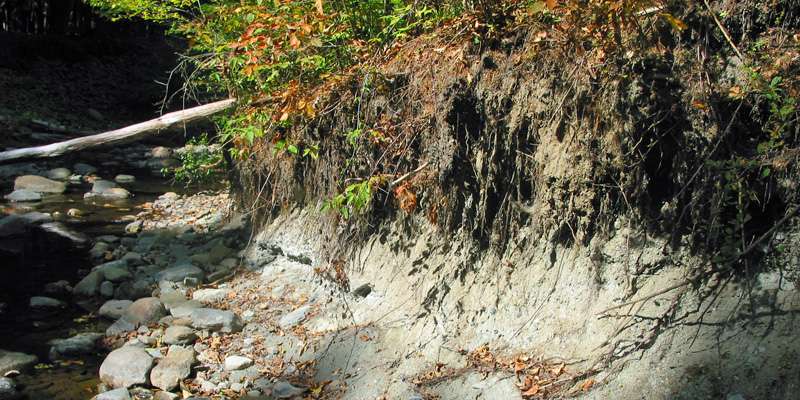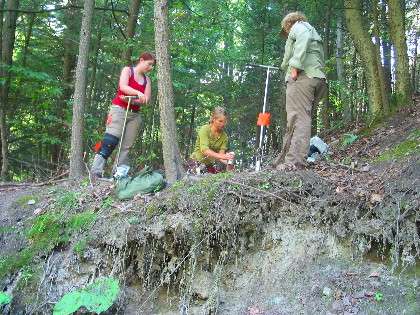Research suggests that streambank erosion may soak up unwanted phosphorus, rather than cause it

For decades, phosphorus pollution has been contributing to unwanted algae blooms in many lakes—including Lake Champlain. A raft of recent research has pointed a finger at eroding streambanks, suggesting that their washed-out soils are a major source of this phosphorus flow.
But a new UVM study complicates that picture, raising questions about whether, in fact, streambank erosion is a culprit in Lake Champlain's phosphorus problem.
The new research shows that, indeed, eroding streambanks may increase the raw-total amount of phosphorus that ends up in the lake—but, unexpectedly, some of these soils might decrease the amount of phosphorus available for algae to use in their growth.
How can that be? In the four Chittenden County streams the UVM team studied, streambank soils were so low in phosphorus that the scientists speculate they may buffer other phosphorus already in the water column—altering its form so that algae can't use it as fertilizer. In short, eroded streambank soils, floating in the water, might actually soak up more phosphorous than they release.
"We were surprised at this result," said UVM professor of plant and soil science Don Ross who led the new study that appeared November 6 in the Journal of Environmental Quality.
Algae availability
With the passage of Vermont's 2015 Clean Water Act and recent action by the Environmental Protection Agency to address Lake Champlain's persistent pollution problems, regulation and management of the "total maximum daily load"—or TMDL—of phosphorus is an increasingly important and contentious political issue in the state.

"We're confirming that streambanks are eroding and providing a lot of phosphorus—but we're challenging the idea that it's as important as people thought," Ross says. That's because he and other scientists increasingly think that the most important measure of phosphorus pollution is not necessarily total amount, but, rather, how much is "bioavailable," he says. In other words, the form of phosphorus is ultimately what determines how much it fuels unwanted summertime algae blooms.
"Environmental management of phosphorus has largely used total phosphorus as the index of phosphorus loading into Lake Champlain," the new study notes. "However, it is the bioavailability of the phosphorus, rather than just its quantity, that drives algal growth."
Ross's team examined remote sensing data—LIDAR and aerial photography images—and took soil tests at dozens of spots along Indian Brook, Alder Brook, Allen Brook, and the LaPlatte River, all of which flow into Lake Champlain. From this information, the scientists concluded that streambank erosion can contribute six to thirty percent of the "total nonpoint phosphorus" flowing into the lake. The new study confirms that streambank erosion has potential to dump a large amount of sediment and phosphorus downstream.
But tests of these streambanks by Ross and a student team—including the study's lead author Eulaila Ishee G'11, as well as former graduate students Kerrie Garvey and Rebecca Bourgault, and then-undergraduate Charlotte Ford—showed such low phosphorus saturation that the scientists concluded "these soils may be phosphorus sinks."
More research
"I don't want to suggest that all streambank soils in the Lake Champlain Basin would not be sources of available phosphorus," Ross cautions. Still, "these suburban Chittenden County streambanks were surprisingly low." In other parts of the state, Ross and other UVM scientists working with the RACC Project (for Research on Adaptation to Climate Change) within UVM's Vermont EPSCoR effort, have been studying streambanks along the Mad River and in the Missisquoi River watershed. "They are not always low," Ross notes.
"The big unanswered question is what forms of phosphorus are the most bioavailable and we need to worry the most about," Ross says. This study shows that a clearer understanding of the sources of phosphorus, and how it interacts in streams and lakes, is still needed—"which means more research," Ross says. Without more study, he worries that regulatory and management efforts might decrease total phosphorus going into the lake, but, he says, "there could be just as much bioavailable phosphorus coming in."
More information: Eulaila R. Ishee et al. Phosphorus Characterization and Contribution from Eroding Streambank Soils of Vermont's Lake Champlain Basin, Journal of Environment Quality (2015). DOI: 10.2134/jeq2015.02.0108
Journal information: Journal of Environmental Quality
Provided by University of Vermont

















